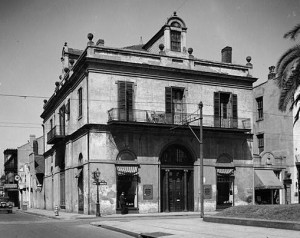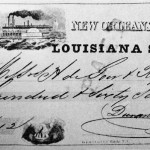 New Orleans’s banks have had a checkered history. Excessive capitalization, Poor banking laws, the panic of 1837, the capture of the city and its long occupation during Reconstruction, the panics of 1873 and 1879, and the bank holidav of 1933 form vivid chapters in the century and a half of New Orleans banking. One of the most interesting old buildings still standing in the Vieux Carre is the Louisiana State Bank, seen here in 1934 at the corner of Royal and Conti streets. Built from the design of the eminent architect Benjamin H. B. Latrobe, it was chartered in 1818 with a capital of $2 million. Very successfully operated, it withstood the panic of 1837 and went through the Civil War. It was converted into the State National Bank in 1870.
New Orleans’s banks have had a checkered history. Excessive capitalization, Poor banking laws, the panic of 1837, the capture of the city and its long occupation during Reconstruction, the panics of 1873 and 1879, and the bank holidav of 1933 form vivid chapters in the century and a half of New Orleans banking. One of the most interesting old buildings still standing in the Vieux Carre is the Louisiana State Bank, seen here in 1934 at the corner of Royal and Conti streets. Built from the design of the eminent architect Benjamin H. B. Latrobe, it was chartered in 1818 with a capital of $2 million. Very successfully operated, it withstood the panic of 1837 and went through the Civil War. It was converted into the State National Bank in 1870.
Its checks bore vignettes of the steamer John Randolph and the pelican and her brood, the state emblem.
 During earlier days, around 1780, there was a shortage of specie (coinage), which was being quickly gobbled up by traders and speculators. Paper currency of various kinds was used in its place, but since this often became worn and illegible through frequent handling, use was sometimes made of cards-even playing cards, which, as the backs were usually plain, could quickly be converted into legal tender by writing in the amounts over an official signature. The illustration depicts a curious example of the use of playing cards as merchandise “scrip,” rather than ordinary currency. The cards are numbered, and bear on their backs an inscription entitling the bearer to receive (presumably from a bakery or storehouse) a stated quantity of bread of a given value. Most of them were signed “Bichot” and were good for two loaves of bread each worth one escalin (i.e., one “bit” or 12 1/2 sous).
During earlier days, around 1780, there was a shortage of specie (coinage), which was being quickly gobbled up by traders and speculators. Paper currency of various kinds was used in its place, but since this often became worn and illegible through frequent handling, use was sometimes made of cards-even playing cards, which, as the backs were usually plain, could quickly be converted into legal tender by writing in the amounts over an official signature. The illustration depicts a curious example of the use of playing cards as merchandise “scrip,” rather than ordinary currency. The cards are numbered, and bear on their backs an inscription entitling the bearer to receive (presumably from a bakery or storehouse) a stated quantity of bread of a given value. Most of them were signed “Bichot” and were good for two loaves of bread each worth one escalin (i.e., one “bit” or 12 1/2 sous).
Today the building is called “Latrobe’s on Royal” and it is used as an events venue. To learn more about Latrobe’s on Royal read the Hotel Monteleone review.
